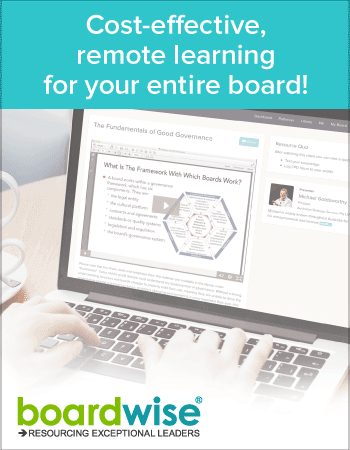How to Present to the Board of Directors
-
governance
Governance How to Present to the Board of Directors
Being asked to present to the board of directors of an organisation is both an exciting opportunity and a daunting challenge. The boardroom environment brings unique pressures and protocols that require advance preparation and care in your approach.
Follow these tips to make the most of your board presentation opportunity.
Why You Might Be Asked to Present
The Board of directors are responsible for making major strategic decisions and overseeing the organisation’s performance. As such, they frequently request presentations (on top of the papers they request to go in the board pack) from managers, subject matter experts, and external advisors to further inform their decision-making.
There are two primary reasons you may be asked to present to the board:
-
To provide information. The board may request an “information paper” on trends in the market, emerging issues, and other topics that will expand their knowledge. While no immediate decision is required, these presentations help directors gain familiarity with subjects they may need to make future decisions about.
-
To support a decision. A “decision paper” presents data, options, and recommendations aimed at enabling the board to make a choice on a specific matter, such as an acquisition, investment, organisational change, or policy. Your role is to provide a logical, persuasive argument to assist their decision process.
In both cases, the board is relying on your expertise, so approach the task as an opportunity to demonstrate your capabilities.
Preparing Your Presentation Approach
Since you will likely have limited time on the agenda, careful preparation is essential for an effective board presentation:
Know your audience. Study the backgrounds, experience and personalities of board members so you can tailor your approach. Also understand their typical presentation preferences.
Review past materials. Read any papers you or others have previously submitted to ensure continuity and identify updates needed.
Focus your message. Identify 2-3 key points you want to make based on the board’s context and needs. Resist including interesting details that don’t directly serve their decision-making.
Write concisely. Board papers should be tightly written with only highly relevant information. Remove anything that doesn’t relate to the purpose. Use our Board Paper Template to help.
Create visuals strategically. Well-designed slides, graphs and photos can aid understanding of key data and issues. But don’t let PowerPoints become dense mini papers.
Practice your delivery. Rehearse an interactive, conversational approach focused on facilitating discussion, not just presenting content.
Mastering Your Mindset
Beyond your tangible preparations, adopting the right mindset is critical for success:
You’re there to help, not impress. Avoid an arrogant attitude or overly theoretical examples. Provide the information directors need in their context.
The board has done their homework. Assume they have thoroughly read your background paper. Don’t repeat its contents verbatim.
Discussion facilitates decisions. Your role is to stimulate thoughtful exchanges between directors leading to decisions.
It’s not about you. The board members carry ultimate responsibility, not you. Enable their process.
Managing the Presentation
Follow these tips when delivering your presentation:
-
Match the room’s energy. Observe the mood in the boardroom and adapt your demeanor accordingly.
-
Make eye contact. Engage directors directly, don’t just talk to the PowerPoint.
-
Use concise language. Speak clearly and avoid rambling since time is limited.
-
Highlight key data. Draw attention to crucial points, trends and recommendations.
-
Invite dialogue. Pause at logical intervals to prompt directors’ questions and input.
-
Admit what you don’t know. Don’t fake answers. Offer to research questions and follow up.
-
Avoid defensiveness. Listen openly to critiques and acknowledge valid concerns.
-
Thank directors for their time and guidance. Express appreciation for the opportunity to present.
After the Meeting
Your responsibilities don’t end when you walk out of the boardroom. Be sure to:
-
Debrief with your sponsor. Ask for feedback on how your presentation was received.
-
Review board meeting minutes/transcript. Note questions asked and suggestions made for follow up.
-
Research information requested. Provide answers in a timely manner based on expectations set.
-
Adjust based on critiques. Reflect on board feedback and improve your skills for next time.
Avoiding Common Presentation Pitfalls
With the right preparation and mindset, you can avoid these common mistakes presenters make:
-
Failing to tailor remarks to the board and its current challenges
-
Including too much theoretical background versus practical perspectives
-
Reading dense slides verbatim without conversational explanation
-
Cramming in tangential details instead of spotlighting critical data
-
Talking too long instead of allowing ample time for director dialogue
-
Answering questions incorrectly or speculatively rather than checking facts
-
Becoming defensive about criticisms rather than embracing them as learning opportunities
Remember, the boardroom environment is unforgiving of major errors. Advance planning and care in your interactions are key.
Using Board Presentations to Advance Your Career
The opportunity to present to the board, when well-executed, can significantly benefit your career advancement. It shows senior leaders your communication abilities, strategic thinking, and expertise on topics valuable to the organisation.
But avoid viewing board presentations primarily as a chance to gain visibility. Maintain a mindset of service to the directors’ process. Let your capabilities shine through subtlety in the quality of information you provide and interactions you facilitate.
With the right reputation for adding value in the boardroom, you become someone directors want to invite back. These repeat engagements allow you to build strong relationships and gain insights into corporate governance processes and high level strategic issues.
That expertise and network serves you well for advancement to executive roles. Board and committee experience also positions you for eventual directorship opportunities across your industry.
Presenting to the board of directors requires extensive preparation, a service mindset and skills for facilitating productive discussion. Manage the dynamics of this high-stakes environment correctly, and you gain visibility, learn governance issues and build relationships to propel your leadership career.
Additional Resources
10 tips to present effectively to your board
Your Guide to More Effective Board Meetings
Presenting to Boards: practical skills for corporate presentations
How to run remote board meetings securely and effectively
Frequently Asked Questions
How do you to give a presentation to a board of directors?
Giving a presentation to a board of directors can be intimidating, but being well prepared is key. Have a clear objective, structure your information logically, and practice your delivery.
Use visual aids like slides or handouts to communicate key data. Allow time for questions and discussion. Dress professionally and speak confidently. Demonstrate your expertise but don't overwhelm with unnecessary details.How do you present to the board for the first time?
Clearly explain the purpose and objectives early on. Don't assume knowledge. Focus on communicating key insights, data, and recommendations. Avoid unnecessary details. Use visual aids like slides, handouts, or charts to emphasise important information. Allocate time for Q&A and discussion. Engage the board in two-way dialogue. Dress professionally and project confidence through body language and tone of voice.
What should be included in a board meeting presentation?
Agenda stating purpose, goals, and topics to be covered. Executive summary highlighting most critical points. Data analysis and trends in graphical formats. Benchmarks or comparisons to goals/competition. Options, recommendations, and/or requests for input. Q&A section to address questions. Contact information for follow up.
How do you act in a board meeting?
Arrive early and set up any visual aids or handouts needed. Introduce yourself and greet board members. Maintain eye contact and speak slowly and clearly. Answer questions directly and admit when you don't know. Stay calm and poised if asked difficult questions. Bring copies of your presentation for board members to reference.
How do you stay calm in a board meeting?
Prepare thoroughly to build confidence. Take deep breaths before entering the room. Channel nervous energy into passion for your work. Focus on listening attentively rather than worrying. If you make a mistake, correct it and move on. Remember the board wants you to succeed.
What to do when nervous before a board meeting?
Visualise yourself presenting successfully. Arrive early to settle in and test equipment. Review your notes but don't obsess over details. Have a bottle of water handy to take sips if needed. Do light stretches to release tension in your body. Approach the board members confidently and remember to smile.
-



